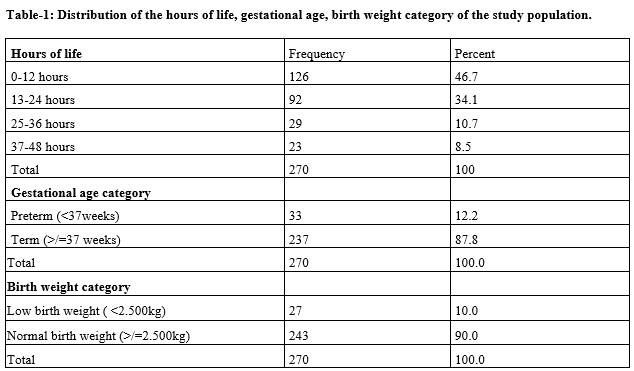A cross-sectional study on the correlation between postnatal foot length and various other anthropometric parameters along with the gestational age
Abstract
Introduction: This study was done to assess the utility of foot length in determining the anthropometric parameters of a newborn in a tertiary care teaching hospital.
Materials and Methods: This cross-sectional study among 270 newborns were done at Sri Venkateswaraa medical college hospital and research centre, from Nov 2018 to May 2020. All the healthy live newborns were taken into the study and newborns with congenital lower limb anomalies were excluded.
Results: The mean birth weight of the neonate 2.948+0.344 kg which ranged from 2.050 kg to 3.750kg. The mean foot length, head circumference and chest circumference of the foot length was 8.113+0.468 cm, 48.989+1.093 cm, 34.437+0.659 cm and 32.372+0.734 cm respectively. The foot length had a maximum correlation with birth weight (r-value=0.905) followed by gestational age (r-value=0.809), length (r-value=0.786), head circumference (r-value=0.719) and chest circumference (r-value=0.603).
Conclusion: Foot length had a significant correlation with birth weight and gestational age of the neonates. Foot length also correlated significantly with other anthropometric variables like length, head circumference and chest circumference.
Downloads
References
Newborns: reducing mortality [Internet]. [cited 2020 Aug 2]. Available from: https://www.who.int/news-room/fact-sheets/detail/newborns-reducing-mortality.
Kramer MS. Determinants of low birth weight: methodological assessment and meta-analysis. Bull World Health Organ. 1987;65(5):663-737.
WHO | The world health report 1995 - bridging the gaps [Internet]. WHO. World Health Organization; [cited 2020 Aug 2]. Available from: https://www.who.int/whr/1995/en/.
Andersen HF, Johnson TR, Barclay ML, Flora JD. Gestational age assessment. I. analysis of individual clinical observations. Am J Obstet Gynecol. 1981;139(2):173-177. doi: 10.1016/0002-9378(81)90441-5.
Ballard JL, Khoury JC, Wedig KL, Wang L, Eilers-Walsman BL, Lipp R. New Ballard Score, expanded to include extremely premature infants. J Pediatr. 1991;119(3):417-423. doi: 10.1016/S0022-3476(05)82056-6.
Mukherjee S, Roy P, Mitra S, Samanta M, Chatterjee S. Measuring New-Born Foot Length to Identify Small Babies in Need of Extra Care: a Cross-Sectional Hospital Based Study. Iran J Pediatr. 2013;23(5):508-512.
Elizabeth NL, Christopher OG, Patrick K. Determining an anthropometric surrogate measure for identifying low birth weight babies in Uganda: a hospital-based cross-sectional study. BMC Pediatr. 2013;13:54. doi: 10.1186/1471-2431-13-54.
Khan N, Mozumdar A, Kaur S. Determinants of low birth weight in India: An investigation from the National Family Health Survey. Am J Hum Biol. 2020;32(3):e23355. doi: 10.1002/ajhb.23355.
Rakkappan I, Kuppusamy N. Newborn Foot Length Measurement to Identify High-risk Neonate. Int J Sci Stud. 2016;4(2):13-19. doi: 10.17354/ijss/2016/243.
Ahankari A, Bapat S, Myles P, Fogarty A, Tata L. Factors associated with preterm delivery and low birth weight: a study from rural Maharashtra, India. F1000 Res. 2017;6:72-72. doi: 10.12688/f1000research. 10659.1
Marchant T, Jaribu J, Penfold S, Tanner M, Armstrong Schellenberg J. Measuring newborn foot length to identify small babies in need of extra care: a cross sectional hospital-based study with community follow-up in Tanzania. BMC Public Health. 2010;10:624. doi: 10.1186/1471-2458-10-624.
Taksande A. Neonatal Foot Length: An Alternative Predictor of Low-Birth-Weight Babies in Rural India. Acad J Pediatr Neonatol. 2016 Aug 5;1:555–69. doi: 10.19080/AJPN.2016.01.555569.
Mullany LC, Darmstadt GL, Khatry SK, Leclerq SC, Tielsch JM. Relationship between the surrogate anthropometric measures, foot length and chest circumference and birth weight among newborns of Sarlahi, Nepal. Eur J Clin Nutr. 2007;61(1):40-46. doi: 10.1038/sj.ejcn.1602504.
Sreeramareddy CT, Chuni N, Patil R, Singh D, Shakya B. Anthropometric surrogates to identify low birth weight Nepalese newborns: a hospital-based study. BMC Pediatr. 2008;8:16. doi: 10.1186/1471-2431-8-16.
Srinivasa S, Manasa G, Madhu G. Foot length of newborn: Its correlation with gestational age and various anthropometric parameters. Curr Pediatr Res. 2017;21(2):248-253. Available at https://www.alliedacademies.org/articles/foot-length-of-newborn-its-correlation-with-gestational-age-and-various-anthropometric-parameters.html
Wyk LV, Smith J. Postnatal Foot Length to Determine Gestational Age: A Pilot Study. J Trop Pediatr. 2016;62(2):144-151.
Gavhane S, Kale A, Golawankar A, Sangle A. Correlation of foot length and gestational maturity in neonates. Int J Contemp Pediatr. 2016;3(3):705-708. doi: 10.18203/2349-3291.ijcp20162212.

Copyright (c) 2021 Author (s). Published by Siddharth Health Research and Social Welfare Society

This work is licensed under a Creative Commons Attribution 4.0 International License.


 OAI - Open Archives Initiative
OAI - Open Archives Initiative


